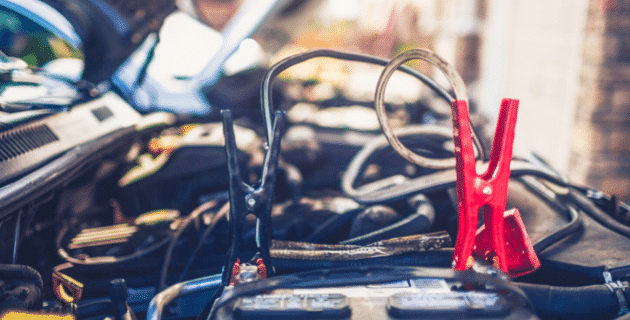Car batteries don’t last forever. Luckily, if your car won’t start due to a dead battery, there’s an easy fix. You can jump start it.
Jump starting a car transfers the battery power from a live battery in one vehicle to the dead battery in another. It does this by creating a circuit, most commonly using jumper cables. Jump starting isn’t a permanent fix, but it will help you get to where you’re going. And then, you can schedule a follow-up with your mechanic to check your battery and replace it as needed.
It’s not difficult to jump start a car, but you do need to know how to do it properly. If you do not connect the cables in the right way and in the exact order, you could be in for trouble. Follow this process to successfully jump start your car — or someone else’s — this season.
1. Park so that your car’s engine is next to the other car’s engine without touching. In most cases, your cars will have to be facing each other in order for the jumper cables to reach.
2. Place both vehicles in park or neutral. Shut off the ignition. Put on the parking brake.
3. Pop the hoods. Locate the batteries.
4. Get out the jumper cables. Note that they have red and black clamps.
5. Attach one of the red clamps to the positive terminal on the dead battery. Look for the big plus sign or the letters POS to make sure it is positive. Sometimes the positive terminal is also the larger one. (Always connect the dead battery first. Otherwise, you could be feeding energy in the cables and cause a safety hazard.)
6. Attach the other red clamp to the positive terminal on the battery of the working battery.
7. Clamp the black negative to the negative terminal of the working battery.
8. Attach the last black clip to an unpainted metal surface on the car with the dead battery. You can find such a surface on one of the metal struts that holds the hood open.
9. Start the working vehicle and let the engine run for a few minutes.
10. Try to start your vehicle. If it doesn’t start right away, give it another minute and then try again.
11. Remove the cables in the reverse order that you connected them.
12. If the jump start works, don’t shut off your vehicle. Drive around for at least 15 minutes to recharge your battery. And always remember to thank the person who helped you!
If you want to jumpstart your car on your own, you can buy a battery jumper pack. Most people consider this one of the must-carry safety items for your car in the winter. A battery jumper pack is a portable battery with cables that can jump-start your car without the need of another vehicle. If you choose to go this route, be sure to carefully follow the directions. The procedure varies from device to device.
If you feel unsure or unsafe at any point, call for 24/7 roadside assistance. You can also call if the jump start does not work and you need a tow.
Do’s and Don’ts of Jump Starting
Now that you have the basics down, it’s good to review some safety do’s and don’ts.
Do…
-
- Read your owner’s manual on jump starting. In some cases, jump starting may void the warranty. In other cases, there may be jump start lugs where cables need to be attached. The manual will detail any special instructions.
-
- Make sure the battery on the good Samaritan’s vehicle has at least as much voltage as your own. Otherwise, serious damage could occur.
-
- Check that the clamps on the jumper cables are rust-free.
-
- Check that the battery does not have corrosion or rust. You can clean corrosion and dirt with a wire brush. (Corrosion will sometimes prevent the battery from charging.)
-
- Unplug accessories like cell phone chargers. The power surge from the jump start could cause them to short out.
-
- Turn off headlights, hazard lights, turn signals, and the radio in both vehicles.
-
- Use rubber gloves and safety goggles if you have them for extra safety.
Don’t…
-
- Lean over the battery of either car.
-
- Smoke while jump starting a car.
-
- Jump start a battery if it is cracked, leaking or the fluids are frozen. This can lead to an explosion.
-
- Ignore the warning signs:
-
-
- Slow starting engine
- Dim lights and electric issues
- Check engine light is on
- Corroded connectors
- Rotten egg smell
-
And don’t forget! AutoZone offers free battery testing so you can feel confident that your battery is fully charged.
Finally, remember to turn your lights off. We all know how that typically ends.
Safe travels.
This article is furnished by California Casualty, providing auto and home insurance to educators, law enforcement officers, firefighters, and nurses. Get a quote at 1.866.704.8614 or www.calcas.com.
- Graduation – When to Remove Your Child from Your Auto Policy - May 18, 2023
- How to Prevent Catalytic Converter Theft - May 17, 2023
- How Much Does Home Insurance Cost? - May 17, 2023

